How to modernize your home | Complete guide
Discover how you can modernize your home with the furniture you have, give a second life to your antique furniture and modernize your home with these ideas.
Mixing Old and New: A Growing Trend
In interior decoration, the combination of old and new elements has become a very popular trend in recent years. This mix offers a unique balance between nostalgia and contemporary style, creating spaces full of personality and character. The key to this trend lies in leveraging the charm and history of antique furniture while adapting it to the context of a modern home that seeks functionality, comfort, and minimalist aesthetics.
The appeal of this hybrid style lies in its ability to tell a story: antique furniture speaks of past eras, of decorative styles that have withstood the test of time, while modern elements bring freshness, lightness, and visual simplicity. Moreover, mixing both styles results in a less predictable and more original space, avoiding an atmosphere that's too cold or overly cluttered.
Advantages of Using Antique Furniture in a Modern Home
- Sustainability and environmental awareness: Investing in antique furniture is a way of reusing what already exists, reducing the demand for mass production and the consumption of natural resources. By restoring old pieces, we also avoid generating unnecessary waste.
- Quality and durability: Many antique furniture pieces were made with high-quality materials and expert craftsmanship. Often, these pieces are more durable than mass-produced products today, making them a long-term investment.
- History and emotional value: Antique furniture often has a sentimental or historical value not found in new furniture. Whether it's a family heirloom or a piece acquired at an antique market, each object tells a story, bringing special meaning to the space.
- Uniqueness and style: Unlike mass-produced furniture, antique pieces are unique. Incorporating these elements into a modern home ensures that the home will have a personalized and distinctive style. The combination of old and new creates an eclectic decor with much more personality than a purely contemporary space.
- Versatility: Antique furniture can be very versatile if properly adapted or restored. An old sideboard, for example, can serve as an elegant storage piece in a modern living room, while a vintage dining table can become the centerpiece of a minimalist kitchen.
Evaluating Space and Antique Furniture
Before modernizing a house with antique furniture, it's crucial to carefully evaluate both the available space and the characteristics and condition of the furniture you wish to incorporate. This process will help you make informed decisions about which pieces to keep, restore, or adapt, and how to properly integrate them into a modern environment without sacrificing their historical or aesthetic value.
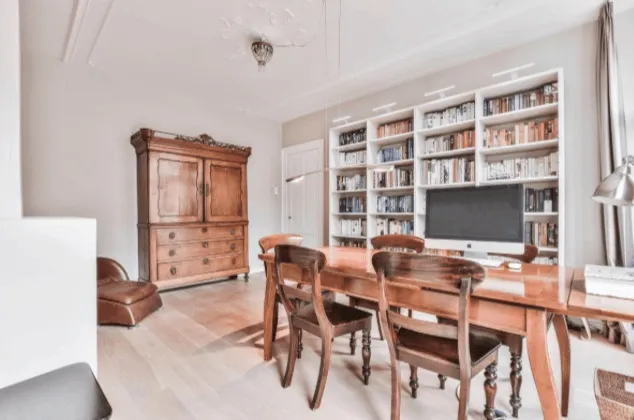
1. Analyzing the Condition of Antique Furniture
The first task is to assess the physical condition of the antique furniture you have or plan to acquire. This will allow you to know which pieces are ready to use as they are, which need restoration, and which may not be viable for modernization.
Key points when evaluating the condition of furniture:
- Structural condition: Check the stability of the furniture. Old pieces may have suffered wear, especially in areas such as chair or table legs, door or drawer hinges, or connections of furniture parts. Make sure the piece isn't too structurally damaged or can be restored with minimal effort.
- Materials: Observe the materials the furniture is made of. Solid wood, for example, can be easily restored, while certain finishes or veneers may require more work. Furniture made with high-quality materials tends to age better and is easier to revitalize.
- Visible wear and damage: Examine if there are scratches, stains, burns, or discoloration that affect the appearance of the furniture. Many of these imperfections can be corrected with simple restoration techniques, such as sanding, painting, or varnishing. However, if the damage is extensive, it may not be worth the effort or cost of restoration.
- Originality or previous restorations: Consider if the furniture has been previously restored and how this affects its value or aesthetics. Sometimes, previous repair attempts may have altered its original appearance or functionality, which will require a new intervention.
2. Identifying Key Pieces to Keep and Restore
Once you've evaluated the condition of the furniture, the next step is to decide which are the key pieces worth keeping, restoring, or reusing. This decision will depend on several factors, such as their sentimental value, unique style, versatility, and ability to fit into the modern environment you want to create.
Factors to consider when selecting key pieces:
- Sentimental or historical value: If the furniture has significant emotional or historical value, such as a family heirloom, it may take priority in the modernization process. Even if it's not the most functional piece, its history can add a lot of character to the home.
- Aesthetics and design: Evaluate whether the furniture design is timeless or has unique details that can stand out in a modern setting. Pieces like antique dressers, sideboards, or dining tables often have lines and shapes that can serve as focal points in a contemporary space.
- Functionality: Consider whether the furniture can have a useful purpose in your daily life. Some antique pieces may be beautiful but impractical, while others, such as bookshelves, tables, or mirrors, can fulfill key functions in your home. If a piece doesn't have a clear use, you might rethink its functionality, such as transforming a wardrobe into a modern shelving unit.
- Scalability and size: Take into account the size of the furniture in relation to the available space. Some antique furniture, especially from past eras, was designed for larger homes and may appear disproportionate in a smaller or more modern space. Sometimes, restoration includes reducing or adapting furniture to better fit the current dimensions of your home.
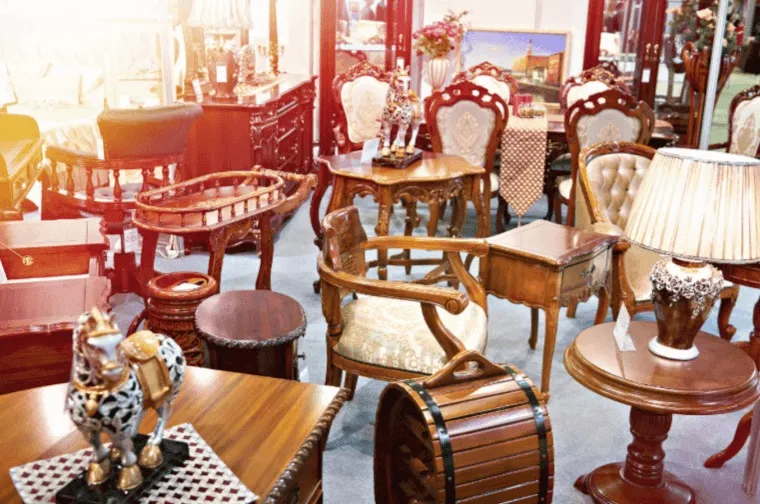
3. How to Select Furniture That Can Integrate into a Modern
Space
Once you've selected the pieces to keep or restore, it's important to think about how they will visually integrate into your space. This is where interior design, composition, and balance between old and new come into play.
Tips for integrating antique furniture into a modern
environment:
- Balanced contrast: Instead of trying to make antique furniture "blend in" with the modern, allow them to stand out by creating intentional contrast. For example, an old, dark wood dining table can look stunning in a kitchen with modern, minimalist lines, paired with contemporary design chairs.
- Combination of materials: Antique furniture is often made of wood, wrought iron, or brass. You can complement these natural textures with modern elements like glass, stainless steel, or matte finishes. For example, a mirror with an antique gold frame can look incredible on a polished concrete wall or next to minimalist design furniture.
- Color palette: Update the visual context of antique furniture through the color palette. Use neutral colors or fresh tones to give prominence to the old pieces. An environment in white, gray, or beige tones will highlight the beauty of the wood or the ornamental details of antique furniture.
- Minimalism: In modern spaces, less is more. Don't overcrowd the space with too many antique pieces. Choose a couple of key pieces that stand out and add character, but keep the rest of the furniture simple and contemporary to avoid the space feeling cluttered.
- Reinterpretation of function: If you find an antique piece you love but it doesn't have an immediate practical use, consider giving it a new function. An old sideboard can become a TV stand, or a vintage dresser can become a bathroom vanity. This reinterpretation will give new life to the furniture within a modern context.
With our virtual home staging tool, you can visualize how these antique pieces will look in a modern environment before making any physical changes. With this technology, you can experiment with different layouts, wall colors, and style combinations, ensuring that the integration of antique furniture into your modern decor is perfect, without having to move a single piece of furniture until you're completely satisfied.
What Types of Antique Furniture Can I Restore and Modernize
Customizing antique furniture is an excellent way to maintain its character and beauty while adapting it to a more modern and functional style. This process involves care and renovation techniques, but it can also include certain creative touches to combine the classic with the contemporary. Below, we'll explore how you can restore antique furniture and add a personal touch without losing its essence.
Basic Restoration Techniques: Cleaning, Painting, and Touch-ups
The restoration of antique furniture begins with restoring its original shine and solidity. For this, there are some basic techniques that can make a big difference:
Deep Cleaning
Before any intervention, it's essential to thoroughly clean the furniture to remove dirt, dust, and residues accumulated over time.
Materials: You can use warm water with mild soap or specific solutions for wood, metal, or upholstery, depending on the material of the furniture.
Process: Use soft cloths to avoid scratches and make sure to dry the furniture well after cleaning. For very old or valuable furniture, it's advisable to consult an expert to avoid damage to the finishes.
Sanding
If the furniture surface has imperfections, such as scratches or deteriorated varnish layers, sanding is an effective technique to smooth and level the wood. Choose fine or medium-grit sandpaper to avoid wearing down the furniture too much.
Process: Sand gently following the direction of the wood grain. Be sure to remove dust after sanding, as any residue can affect the next restoration steps.
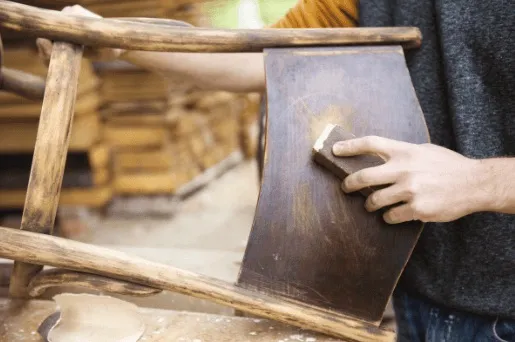
Structural Repairs
Some antique furniture may have loose or damaged parts. In these cases, it's important to reinforce joints with wood glue or even replace screws or hinges.
Process: Make sure to use materials similar to or compatible with the original furniture to maintain its integrity and style.
Painting and Varnishing
Once the furniture is clean and repaired, painting or varnishing can give it a renewed look. Depending on the style you want, you can choose to maintain the natural color of the furniture by applying only varnish or give it a more modern touch with paint.
- Varnishing: If you prefer to preserve the original look of the wood, a clear varnish can help highlight its grain and give it new life.
- Painting: If you're looking for a more contemporary style, you can opt to paint the furniture in neutral tones or vibrant colors, depending on your home's decor. Choose high-quality wood paints and apply several thin coats for a professional finish.
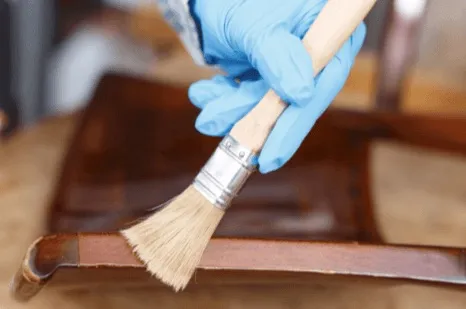
Ideas for Personalizing Antique Furniture Without Losing Its
Essence
Personalizing an antique piece of furniture is a fantastic way to integrate it into a modern home without distorting its original charm. Here are some ideas that will help you maintain the balance between old and new:
Changing Knobs or Hardware
A simple but effective way to modernize an antique piece of furniture is to replace the original knobs or hardware with contemporary design ones. Metal hardware in tones such as matte gold, bronze, or black can give an elegant and modern touch without changing the essence of the furniture.
New Upholstery for Chairs and Armchairs
For furniture that includes upholstery, such as chairs, armchairs, or sofas, changing the fabric can completely transform its appearance. By opting for a modern but high-quality fabric, you can update the piece without losing its original structure and shape.
Suggestion: Use textiles in solid tones or geometric patterns that contrast with the classic structure of the furniture. Fabrics such as velvet, linen, or cotton can give a sophisticated and contemporary touch.
Prints and Decoupage Techniques
If you want to give a more artistic touch to the furniture, you can apply techniques such as decoupage, which involves gluing paper or fabric cutouts onto the furniture surface and then sealing them with varnish or lacquer.
Process: You can choose floral, geometric, or abstract motifs depending on the style you're looking for. This is a perfect technique for side tables, dressers, or shelves.
Adding Color Details
A subtle but effective strategy to personalize antique furniture without altering its essence too much is to paint details such as edges, legs, or drawer interiors in bright or metallic colors. This touch of color adds modernity without compromising the classic design of the furniture.
Combining Classic with Modern Colors or Finishes
The key to modernizing antique furniture is to achieve a balance between classic and modern, and one of the most effective ways to do this is through the combination of colors and finishes.
Neutral and Elegant Colors
Neutral tones such as white, gray, beige, or black are ideal for softening the appearance of an antique piece of furniture and allowing it to easily integrate into a modern environment. These colors bring freshness and lightness to the robust structure of classic furniture.
Example: Painting an antique Baroque-style dresser in matte white can turn it into a modern and elegant piece for a minimalist bedroom.
Vibrant Colors as Accents
If you prefer a bolder approach, you can opt for vibrant colors such as turquoise blue, emerald green, or mustard yellow to renovate a piece. This works particularly well on smaller furniture, such as side tables or chairs, where the strong color serves as a decorative accent.
Metallic or Lacquered Finishes
Another modern resource is to incorporate metallic or lacquered finishes on some details of the furniture. The high-gloss lacquered finish brings a contemporary air, while metallic finishes, such as copper or aged gold, add a touch of luxury.
Controlled Aging Technique (Patina)
If you're interested in maintaining a classic look but with an updated touch, you can apply the patina or controlled aging technique. This process allows you to highlight the antique character of the furniture while giving it a renewed and sophisticated appearance.
With virtual home staging it's possible to simulate different decoration styles and layouts, which helps in making more informed decisions about how you could restore and personalize your furniture.
Balance Between Old and New
Creating a harmonious balance between antique furniture and modern elements is an art that allows you to blend the best of both worlds, combining the elegance and history of the classic with the functionality and freshness of the contemporary. Achieving this fusion without the space looking disorganized or incoherent can be a challenge, but with the right principles, you can achieve a stylish and balanced environment in your home.
How to Achieve Visual Harmony Between Antique Furniture and
Modern Elements
The first step to integrating antique furniture into a modern environment is to achieve visual harmony. This implies that, although the pieces have different styles, the ensemble should feel balanced and coherent. Here are some strategies to achieve this balance:
Selection of Key Pieces
Not all furniture in a room needs to be antique or modern. Instead of saturating the space with too many disparate styles, select a few key pieces that act as focal points. For example, a modern straight-lined sofa can perfectly complement a vintage coffee table or an antique dresser. The key is to allow one or two antique pieces to be the center of attention, while modern furniture provides the neutral background.
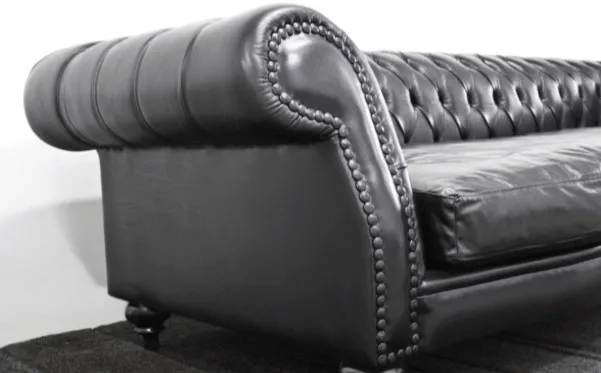
Proportions and Scale
It's important to consider the proportions and scale of the furniture. A large antique piece of furniture, such as a dresser or sideboard, can overwhelm a space if not balanced with other elements. Conversely, a smaller antique piece can get lost if surrounded by too bulky furniture. Maintaining an adequate proportion between different styles will ensure that everything flows visually in the space.
Repetition of Shapes and Lines
Another way to unite old and new is to find elements that share similar shapes or lines. For example, if you have an antique piece of furniture with curves, such as a Louis XV-style chair, you could pair it with a modern curved design table or with decorative objects that have rounded shapes. This repetition of similar lines or shapes helps to visually connect different styles.
Balance Between Ornamentation and Simplicity
Antique furniture tends to be more ornate, with carved details, curves, or intricate decorations. In contrast, modern furniture is usually characterized by clean lines and simplicity. To achieve visual balance, it's important not to overload the space with too many ornamental details. If an antique piece is very eye-catching, balance it with simpler, more minimalist modern furniture, so that there's an attractive contrast between opulence and sobriety.
Use of Neutral or Contrasting Color Palettes
The color palette you choose for your space plays a crucial role in how the combination of antique and modern furniture is perceived. You can opt for a neutral and soft palette to create a serene ambiance, or you can play with bolder contrasts to make each piece stand out.
Neutral Colors as a Base
Using a neutral color palette (whites, grays, beiges, light browns) as a base will allow you to harmonize disparate styles without creating visual conflict. Neutral colors act as a blank canvas that enhances the beauty of antique furniture while facilitating the integration of modern pieces.
Tip: If you have an antique piece of furniture with a particular color or finish, surrounding it with neutral walls and floors will allow it to be the protagonist of the space without looking out of place.
Color Contrasts
If you prefer a bolder approach, you can use color to create deliberate contrasts between old and new. For example, a restored antique chair can be painted in a vibrant color (like cobalt blue or emerald green) to give it a contemporary touch that contrasts with the rest of the modern furniture in neutral tones.
Tip: Use contrasting colors to highlight the uniqueness of antique pieces. Walls in dark tones, such as charcoal gray or navy blue, can make a light-colored antique piece or one with gold details stand out spectacularly.
Metallic Tones and Shiny Finishes
Incorporating metallic tones (such as gold, copper, or silver) in small details can unite old and new. Metallic finishes provide a sophisticated and contemporary touch, and are particularly useful for linking different styles, whether through lamps, mirror frames, or furniture hardware.
Monochromatic Colors with a Touch of Contrast
If you prefer a minimalist approach, you can use a monochromatic palette with slight contrasts to soften the difference between old and new. For example, if your space is predominantly white or gray, add a touch of color through a single antique piece painted in a dark tone or aged wood that subtly stands out.
Mixing Materials: Wood, Glass, Metal, etc.
The combination of materials is an effective way to balance old and new, bringing visual and tactile variety without the space looking cluttered. By playing with different textures, such as wood, metal, glass, or marble, you can create a rich and dynamic environment.
Wood: The Classic That Never Fails
Wood is one of the most common materials in antique furniture, but it's also widely used in modern design. You can balance the warmth of an antique dark wood piece with other lighter materials, such as glass or metal, to modernize its appearance.
Example: An antique wooden sideboard can be accompanied by a modern glass coffee table, creating an elegant contrast between the solidity of wood and the lightness of glass.
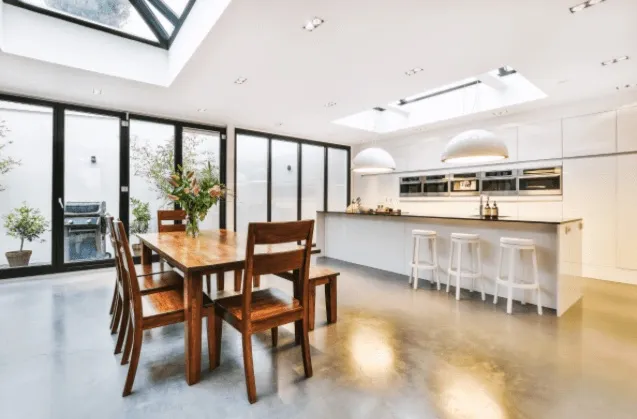
Metal: A Contemporary Connection
Metal (steel, aluminum, bronze, or brass) is an excellent material for adding a modern touch to a space with antique furniture. Metal legs on tables, copper hanging lamps, or wrought iron details on contemporary furniture can help link styles effortlessly.
Example: A dining table with a modern metal base can be combined with antique wooden chairs to create an eclectic but balanced ambiance.
Glass: Transparency and Lightness
Glass is a material that brings modernity and visual lightness, and works well in spaces where antique furniture that tends to be more robust predominates. Incorporating glass elements (such as side tables or shelves) helps soften the visual weight of classic pieces and brings a sense of spaciousness.
Tip: Tables with glass tops are perfect for showcasing the beauty of an antique piece without overcrowding the space.
Textiles: Softness and Comfort
Modern textiles, such as minimalist rugs, geometric cushions, or linen curtains, can bring softness and texture while balancing the robustness of antique furniture. The contrasts between simple, modern fabrics and classic upholstery can give the space a cozy and dynamic feel.
How to Modernize Your Home
Integrating modern accessories into an environment decorated with antique furniture is an excellent way to balance the space and modernize a home. Accessories, such as lighting, textiles, and art, bring a contemporary freshness that highlights and complements classic pieces, creating a unique and harmonious ambiance. Below, we explore how to use modern elements to accentuate and balance antique furniture in your home.
Contemporary Lighting to Highlight Antique Furniture
Lighting is one of the most important aspects when combining styles in decoration. Modern lamps can not only enhance the beauty of antique furniture but also bring a touch of modernity to the space.
Modern Design Pendant or Chandelier Lamps
An effective way to introduce a contemporary element is through the use of pendant or chandelier lamps with current and minimalist designs. For example, a chandelier with clean lines and materials such as glass, steel, or copper can create a beautiful contrast when placed over an antique wooden table or in a room with a vintage dresser.
Example: An antique oak dining table can be revitalized under a modern black steel pendant lamp with exposed bulbs, creating an attractive visual contrast that blends classic and contemporary.
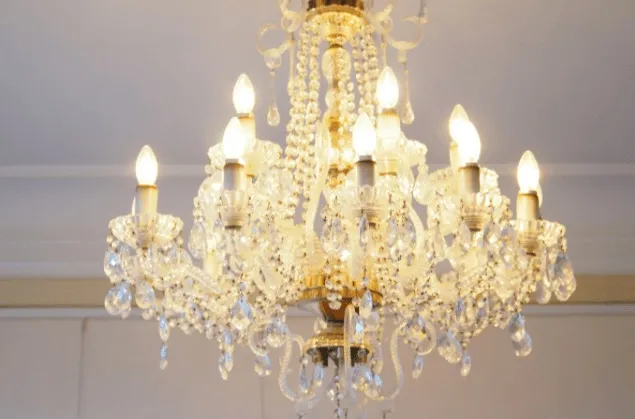
Industrial or Minimalist Style Floor or Table Lamps
Industrial or minimalist style floor or table lamps can also add a modern air to the room without stealing the spotlight from antique furniture. Metal lamps with geometric shapes or those with matte finishes and simple designs balance the detailed ornamentation of classic furniture.
Tip: Place an industrial floor lamp next to an antique armchair or vintage desk. This type of lamp has a functional and elegant look that contrasts wonderfully with the curved lines and carvings of antique pieces.
Accent or LED Lighting to Highlight Details
Another option is to use accent lighting or LED strips to highlight specific details of antique furniture. By strategically illuminating parts of a display cabinet, bookshelf, or dresser with warm lights, you can draw attention to the unique features of the pieces without overcrowding the space with unnecessary details.
Example: Use LED lights under an antique shelf or inside a vintage sideboard to highlight the textures and finishes of the wood, giving it a contemporary and dynamic look.
Incorporating Modern Textiles and Rugs
Modern textiles and rugs are key elements for softening the look of antique furniture and adding comfort to the space. Additionally, textiles help connect different eras and styles in the same room.
Modern Design Rugs
Rugs are an excellent way to bring modernity to a space dominated by antique furniture. You can opt for rugs with geometric designs, abstract patterns, or solid colors to create an interesting contrast with the ornamentation of classic furniture. Rugs with clean lines and neutral tones can provide visual balance without diminishing the prominence of antique furniture.
Example: Place a modern style rug with geometric shapes or in soft tones under an antique coffee table or vintage sofa. This not only frames the furniture but also unifies the different styles in the space.
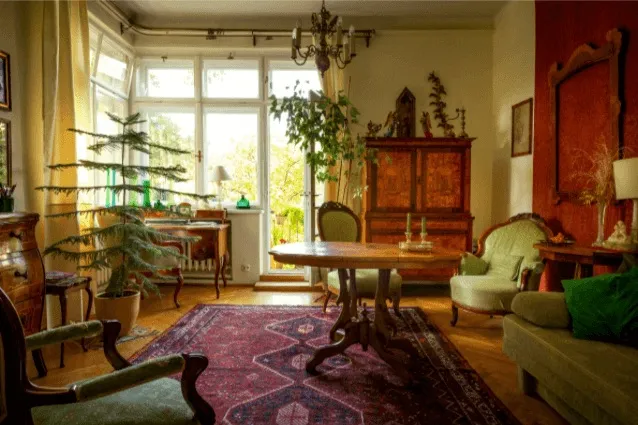
Cushions and Throws with Modern Textures and Patterns
Cushions and throws are a simple and affordable way to modernize the look of antique upholstered furniture, such as sofas, armchairs, or chairs. Opt for solid color cushions, velvet textiles, or wool throws with geometric patterns. These contemporary details soften the robustness of antique furniture and add a touch of freshness.
Tip: Place neutral-colored linen cushions or boho-style throws on a Victorian-style armchair or period chair to effortlessly blend modern and classic.
Light Curtains and Textiles
Modern design curtains, in light fabrics such as linen or cotton, can provide a neutral background that doesn't compete with antique furniture. Long curtains in light tones and simple textures bring brightness and lightness, balancing the visual weight of heavier or more elaborate furniture pieces.
Example: Place white or light gray linen curtains in a living room that has an antique velvet sofa or a carved wooden dresser. The lightness of the curtains will allow the room to look airy and modern, while the classic furniture will remain the protagonist.
Using Art and Minimalist Decoration to Balance the Space
Art and decorative elements play a crucial role in creating a modern ambiance that complements antique furniture. Artwork and minimalist decorations allow you to highlight the uniqueness of classic pieces without visually saturating the space.
Contemporary Art on Walls or on Antique Furniture
Contemporary art pieces, such as abstract paintings or black and white photographs, bring a modern contrast that can perfectly complement antique furniture. Placing a modern artwork above a classic fireplace or vintage dresser creates a visual balance between old and new.
Example: Place a large abstract painting above an antique wooden dresser in the living room. The modernity of the art will make the antique piece stand out even more, creating a fascinating balance between styles.
Minimalist Sculptures or Decorative Pieces
Simple design sculptures or minimalist decorations, such as ceramic vases in neutral tones, can complement antique furniture without overcrowding the space. These pieces help balance the detailed ornamentation of classic furniture and offer visual relief that modernizes the ambiance.
Tip: Place a modern and minimalist sculpture on an antique table or next to a classic piece of furniture to add a contemporary touch that softens the visual complexity of the antique furniture.
Simple Frames and Modern Mirrors
Modern mirrors with minimalist frames can bring brightness and modernity to a room, balancing the visual weight of antique furniture. Mirrors not only visually enlarge the space but also allow classic furniture to be reflected, creating an elegant contrast between eras.
Example: A modern mirror with a thin, geometric frame placed above a vintage sideboard in the hallway can illuminate the space and combine classic and modern in a balanced way.
Use virtual home staging to modernize your home by combining the beauty of antique furniture with a contemporary style.

Related Posts
Top 7 AI Room Decoration Tools for 2025
Discover the best AI room decoration software for 2025. Our review compares top tools to help you de...
9 Curb Appeal Ideas on a Budget That Actually Work (2025)
Transform your home's exterior with our top curb appeal ideas on a budget. Get easy, high-impact tip...
10 Essential Curb Appeal Improvements for 2025
Discover 10 essential curb appeal improvements to boost property value. This guide for real estate p...